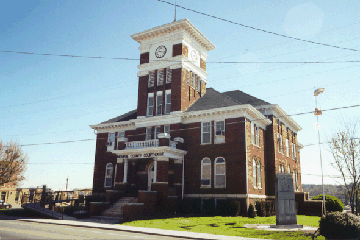

 |

What is now Monroe County was once"Cherokee Indian Territory", where the National
Capital
of the Indian Nation was located. The capital, Chota (Echota), was located near the mouth of the
Tellico River on the Little Tennessee River near Fort Loudoun. The Indian nation covered
40,000 square miles and had a population of 25,000. According to Cherokee law, Chota was
known as a "Peace Village"' meaning that no blood could be shed within its borders.
By 1800, many whites of both sexes had married Indians thereby obtaining land in what was then called the Interior (deep into Indian territory). Monroe County was created by a Private Act of the Tennessee General Assembly November 13, 1819, from part of the Hiwassee Purchase from the Cherokee Indians ( Treaty of 1819, sometimes referred to as the Calhoun Treaty).
Private Acts, 1819 Section 4. Be it enacted, that the said county of Monroe shall be bounded as follows, to wit: Beginning at the beginning of McMinn County thence running eastwardly with the line of Roane County to the Tennessee River; thence up said river to the mouth of Cowee and Nanteyallee; thence with the dividing ridge between said rivers to the eastern boundary line of this state; thence south with said line to the line dividing this state from the state of Georgia thence west to the county of McMinn; thence with the said county to the beginning.
By the same act, the legislature decreed that the administration of justice was to be held at the home of William Dixon on the south bank of the Little Tennessee River, opposite the town of Morganton. Population in the county at this time was 2,529. Monroe County Circuit Court records, the entry is made that Circuit Court was held at the home of William Dixon on the first Monday in May 1820 and that it was "holden by Charles F. Keith, Judge, John B. Tipton appointed Clark, William B. Warren, Justice of peace, Daniel Foute, Clark and John McCroskey, Sheriff.
Some of the first settlers in the vicinity of Tellico Plains were: Thomas, John and Andrew L. Henderson, Austin and Alexander Rider, Samuel McSpadden, James and Michael Ghormley, David and Wm. Stephens, John, Jacob, and Joseph Smith, Wm. and Benjamin Reagan, Wm.Williams, Ainesworth, Carroll and Bradley. Michael Carroll and William Bradley in 1821 erected a small iron furnace, known as Tellico Ironworks. Read the history of Coker Creek. Visit with Tellico, read their history and view the beauty of the area.
The western part of the county was settled by:
Wm. Patton, T.C. and Hugh Goddard, James Axely, Wm. Neal, John Lotspeich,
Daniel Heiskell, John Fine, Charles Owen, Jonas Derrick, Robert Sneed,
Stephen McCaslin, Eli and Pressly Cleveland, Hugh Gregory and Alexander
Biggs. In the central and northern portions of the county we had:
Johnsons, Montgomery, McCray, McCroskey, Kelso, Tipton, McGhee,
Blackburn, Arris, Calloway, Bicknell, and Hicks families.
Goodspeed
For a view of modern
Monroe County
visit this site with us.
![]() Top of Page
Top of Page
![]() Return to Monroe Home Page
Return to Monroe Home Page